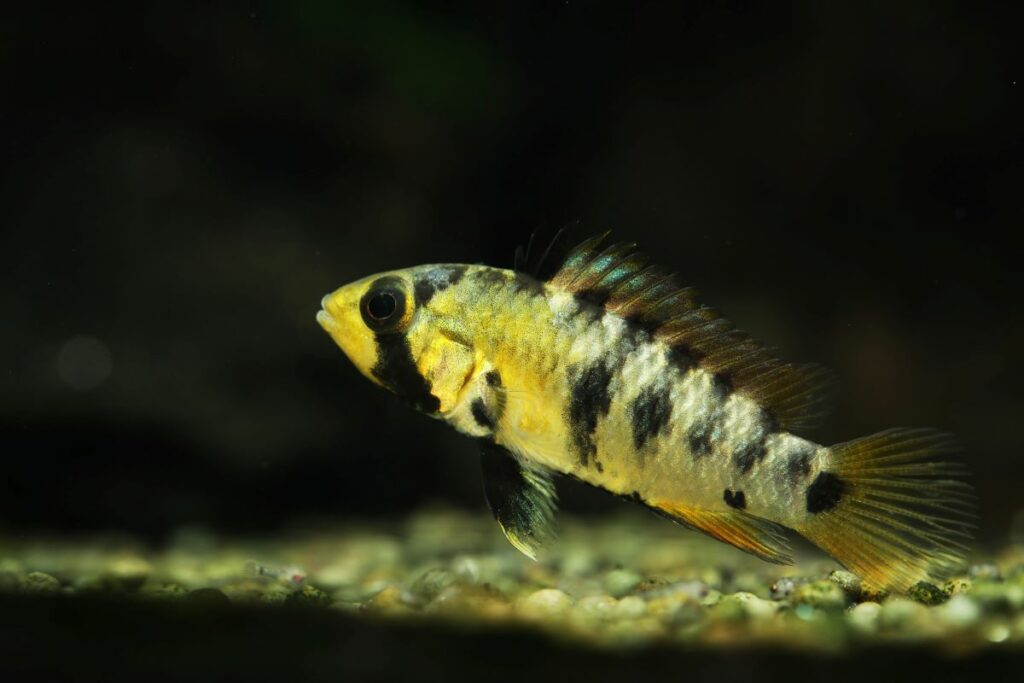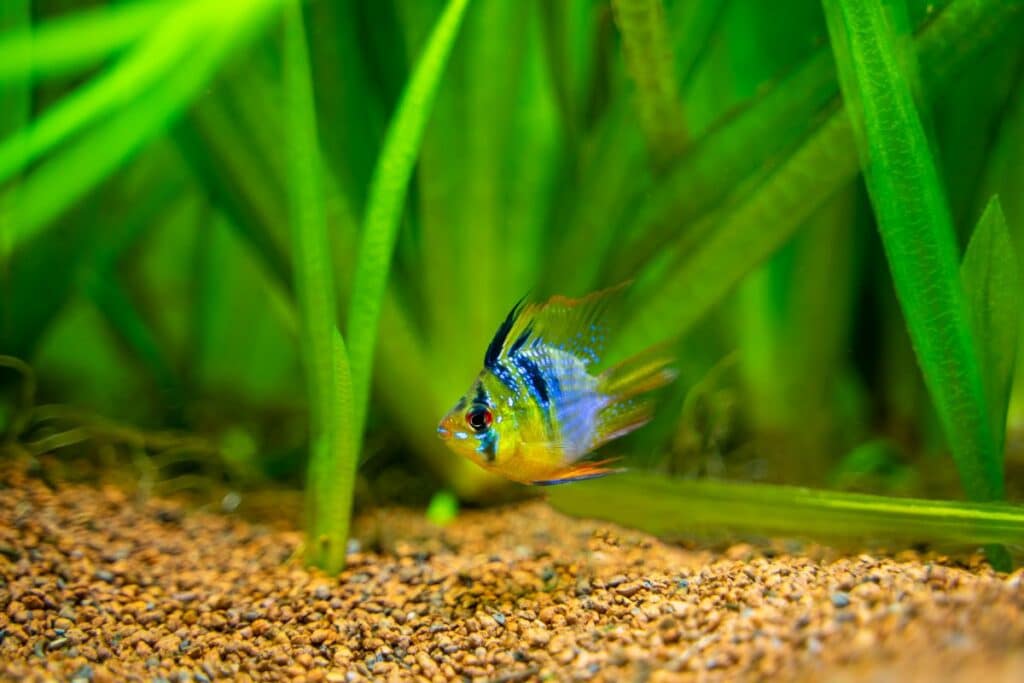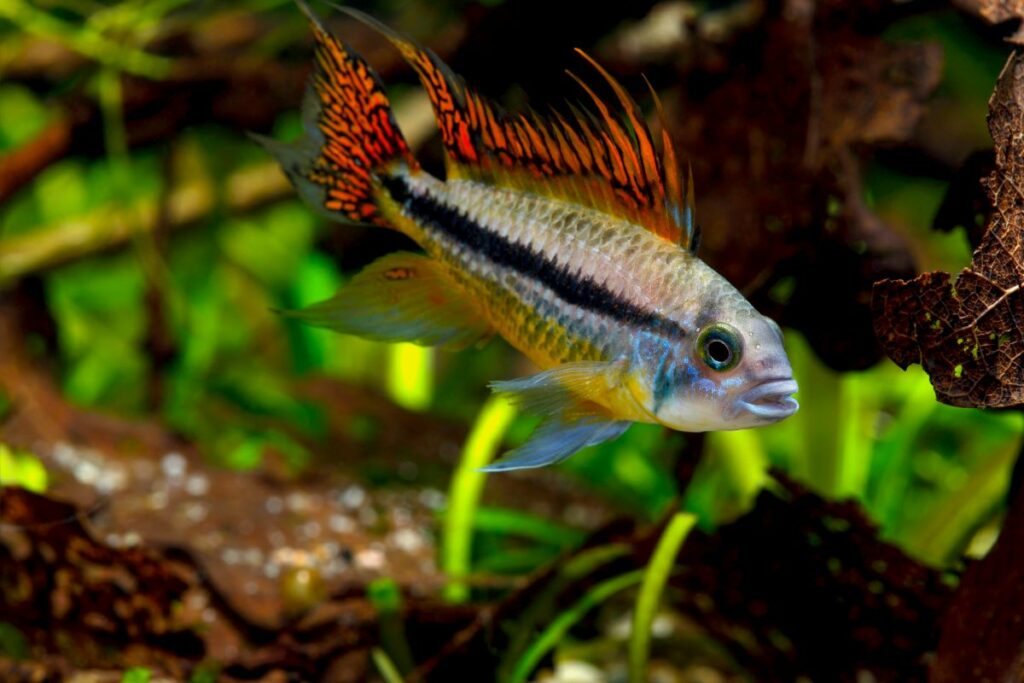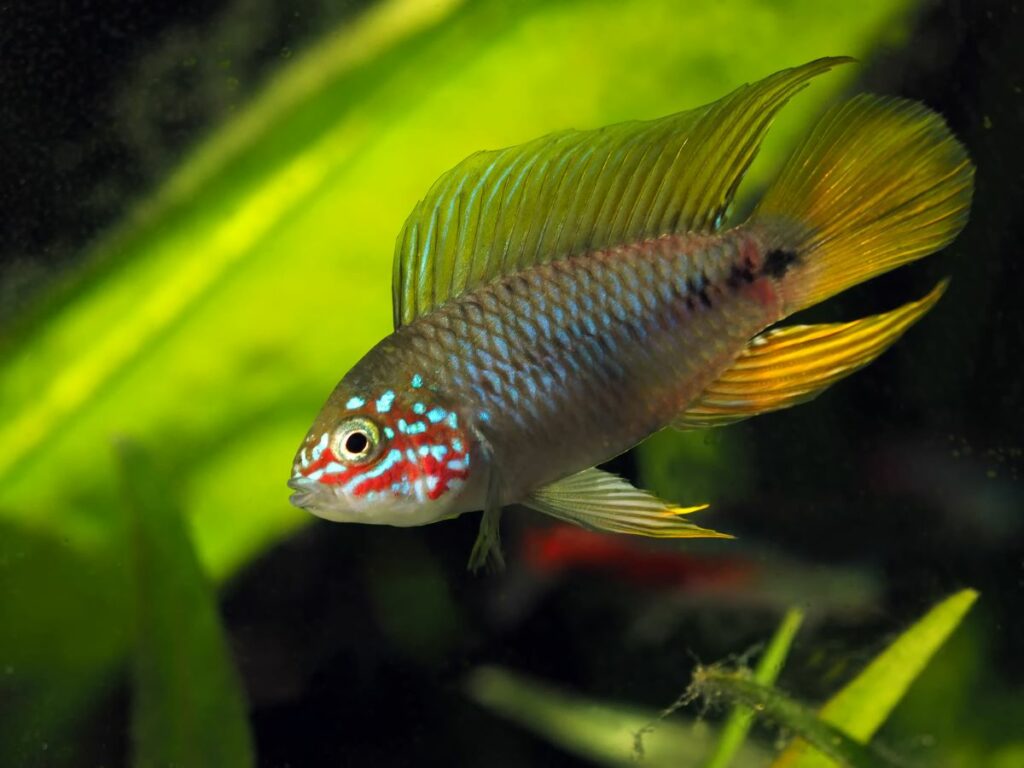the essentials in brief
Dwarf cichlids prefer slightly acidic to neutral water with a pH of around 6,5-7,0. The ideal temperature is around 25-28°C. Find out more about the water conditions here.
Yes, dwarf cichlids can be kept well in a community aquarium with other peaceful fish species. It is important that the roommates are not too aggressive. You can find out more here.
Dwarf cichlids are omnivores and eat both plant and animal food. In nature, they feed mainly on insect larvae. Here you can find out more about the food of a dwarf cichlid.
The dwarf cichlid is a true blaze of color for the eye. For many aquarists, the home aquarium is not only a stylish home accessory, but also a Eye-catcher for relaxed hours.
Anyone looking for a colorful and interesting species of fish that does well in community aquariums should definitely consider the dwarf cichlid (Microgeophagus ramirezi).
origin and characteristics

The dwarf cichlid, also known as the butterfly cichlid or ramirezi, is native to the clear waters of South America, more precisely from the rivers Orinoco and Rio Negro in the Amazon region.
He belongs to Cichlid family (Cichlidae) and impresses with its bright colors and unique physique. The males are often more intensely colored and have longer fins than the females.
Additional information: With good care and suitable living conditions, dwarf cichlids can usually live 2-3 years or even longer.
colors and social behavior
One of the most fascinating characteristics of the dwarf cichlid is undoubtedly its colorful appearance. Depending on mood and brood care, the fish can change their colors and then shine in the most beautiful shades of blue, yellow and red. This makes them an extremely attractive focal point in any aquarium.
In terms of their social behavior, dwarf cichlids are relatively peaceful fish. However, they should not be socialized with species that are too aggressive, as they are rather shy and like to live in a quiet environment.
An attitude in one Group of 5 to 6 animals is recommended to ensure harmonious cooperation.
Note: Dwarf cichlids are relatively small fish and are about 5-7 centimeters long when fully grown. The females are usually a little smaller and more dainty than the males.
Aquarium and water conditions

For species-appropriate keeping, aquarists should have an aquarium with a Minimum size of 80 liters set up for a pair of dwarf cichlids.
An sufficient planting with hiding places is important as this increases the fish's sense of security. Roots and stones can also be used to decorate the aquarium.
As for water parameters, dwarf cichlids prefer slightly acidic to neutral water (pH 6,5-7,0) and a Temperature of about 25-28°C. Regular partial water changes are important to maintain water quality.
feeding and care
are dwarf cichlids omnivore, which in nature live mainly on insect larvae, small crustaceans and vegetable food. In the aquarium they can be fed with high-quality flake or granulated food, supplemented by live or frozen food such as artemia, daphnia or mosquito larvae.
The regular maintenance of the aquarium and observing the behavior of the fish are important to identify potential problems at an early stage. Illnesses can result from unclean water or stress and should be treated promptly.
Dwarf cichlids can for both beginners and experienced aquarists be suitable.
Note: However, a certain amount of experience in aquaristics is recommended, since dwarf cichlids can react somewhat more sensitively to poor water conditions.
reproduction and rearing
The reproduction of the dwarf cichlids is an exciting event. You show a complex courtship behavior, where the males display themselves in all their glory to impress the females.
After successful courtship, the female lays her eggs in a previously selected place, while the male carries out the fertilization. Afterward the pair takes care of the brood together and protects them from possible threats.
The rearing of the young fish can be a challenge and requires special care and suitable food for the tiny fish.
Additional information: The number of eggs laid can vary, but is usually between 100 and 150 eggs per clutch.
Other fish in the aquarium

When choosing fish that can be kept well with dwarf cichlids, it is important similar claims to the water conditions and behavior into account.
Dwarf cichlids are peaceful but also a bit shy fish, so their roommates should as well calm and not too aggressive be. Here are some fish species that tend to socialize well with dwarf cichlids:
- Panda armored catfish (Corydoras panda): These peaceful and sociable bottom dwellers pair well with dwarf cichlids and complement the aquarium with their active nature.
- Loricariidae (Ancistrus spp.): Also known as catfish, they are excellent algae eaters and have a calm demeanor similar to that of dwarf cichlids.
- Shrimp (e.g. Red Fire Shrimp): If there are enough hiding spots, shrimp can be a nice addition as they keep the bottom clean and shouldn't conflict with the perch.
- Tetras (e.g. neon tetras or glow-light tetras): Peaceful tetras that live in the middle or upper water layer can make a colorful and lively addition to the aquarium.
- Mosaic Gourami (Trichopsis pumila): These small labyrinth fish are a good match for the dwarf cichlids due to their size and peaceful demeanor.
- Dwarf rasbora (e.g. dwarf blue or dwarf red rasboa): These small and colorful fish like to swim in schools and provide a harmonious atmosphere in the aquarium.
- Small fin sucker (Otocinclus spp.): These small sucker catfish are excellent algae eaters and do not disturb the dwarf cichlids.
It is important that when socializing you make sure that the selected fish species similar water parameters and temperature needs to have.
The dwarf cichlid - a colorful appearance
The dwarf cichlid is undoubtedly one An enrichment for every community aquarium. With their colorful appearance and interesting social behavior, they will capture the attention of any aquarist.
The proper posture and care this fascinating species of fish rewards the owner with a harmonious and lively aquarium experience. Anyone who chooses these little jewels from South America will definitely enjoy them and enjoy the beauty of the underwater world to the fullest.




